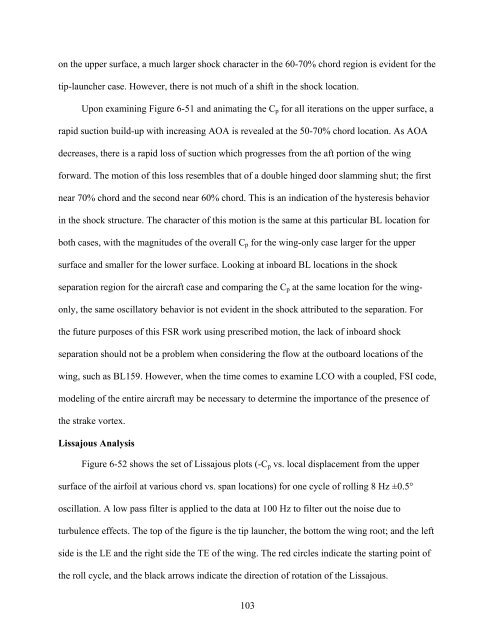university of florida thesis or dissertation formatting template
university of florida thesis or dissertation formatting template
university of florida thesis or dissertation formatting template
Create successful ePaper yourself
Turn your PDF publications into a flip-book with our unique Google optimized e-Paper software.
on the upper surface, a much larger shock character in the 60-70% ch<strong>or</strong>d region is evident f<strong>or</strong> the<br />
tip-launcher case. However, there is not much <strong>of</strong> a shift in the shock location.<br />
Upon examining Figure 6-51 and animating the Cp f<strong>or</strong> all iterations on the upper surface, a<br />
rapid suction build-up with increasing AOA is revealed at the 50-70% ch<strong>or</strong>d location. As AOA<br />
decreases, there is a rapid loss <strong>of</strong> suction which progresses from the aft p<strong>or</strong>tion <strong>of</strong> the wing<br />
f<strong>or</strong>ward. The motion <strong>of</strong> this loss resembles that <strong>of</strong> a double hinged do<strong>or</strong> slamming shut; the first<br />
near 70% ch<strong>or</strong>d and the second near 60% ch<strong>or</strong>d. This is an indication <strong>of</strong> the hysteresis behavi<strong>or</strong><br />
in the shock structure. The character <strong>of</strong> this motion is the same at this particular BL location f<strong>or</strong><br />
both cases, with the magnitudes <strong>of</strong> the overall Cp f<strong>or</strong> the wing-only case larger f<strong>or</strong> the upper<br />
surface and smaller f<strong>or</strong> the lower surface. Looking at inboard BL locations in the shock<br />
separation region f<strong>or</strong> the aircraft case and comparing the Cp at the same location f<strong>or</strong> the wing-<br />
only, the same oscillat<strong>or</strong>y behavi<strong>or</strong> is not evident in the shock attributed to the separation. F<strong>or</strong><br />
the future purposes <strong>of</strong> this FSR w<strong>or</strong>k using prescribed motion, the lack <strong>of</strong> inboard shock<br />
separation should not be a problem when considering the flow at the outboard locations <strong>of</strong> the<br />
wing, such as BL159. However, when the time comes to examine LCO with a coupled, FSI code,<br />
modeling <strong>of</strong> the entire aircraft may be necessary to determine the imp<strong>or</strong>tance <strong>of</strong> the presence <strong>of</strong><br />
the strake v<strong>or</strong>tex.<br />
Lissajous Analysis<br />
Figure 6-52 shows the set <strong>of</strong> Lissajous plots (-Cp vs. local displacement from the upper<br />
surface <strong>of</strong> the airfoil at various ch<strong>or</strong>d vs. span locations) f<strong>or</strong> one cycle <strong>of</strong> rolling 8 Hz ±0.5°<br />
oscillation. A low pass filter is applied to the data at 100 Hz to filter out the noise due to<br />
turbulence effects. The top <strong>of</strong> the figure is the tip launcher, the bottom the wing root; and the left<br />
side is the LE and the right side the TE <strong>of</strong> the wing. The red circles indicate the starting point <strong>of</strong><br />
the roll cycle, and the black arrows indicate the direction <strong>of</strong> rotation <strong>of</strong> the Lissajous.<br />
103
















